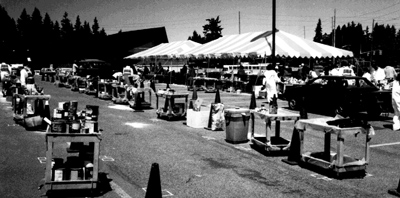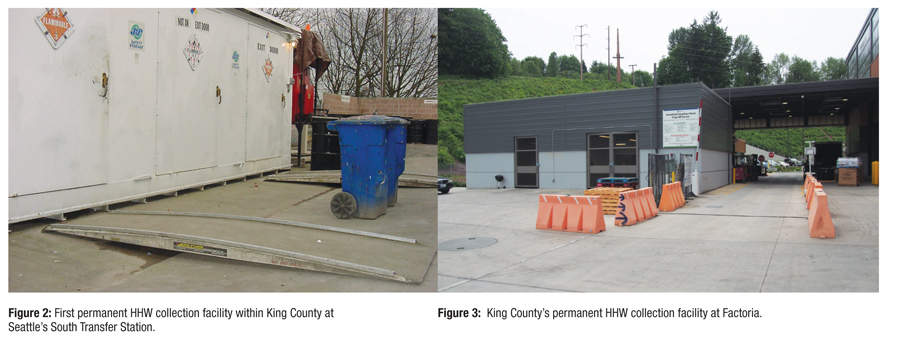The inception of the HHW movement and the early efforts to manage HHW.
By David Nightingale, CHMM, S.C.
Thousands of professionals have been engaged with HHW and Very Small Quantity Generator (VSQG) programs during the past two to three decades. To provide perspective on this relatively new profession, HHW Corner will occasionally interview some of the prominent figures or luminaries who have been instrumental in the development and evolution of this field of endeavor.

Photos courtesy of Special Waste Associates.
We will start by interviewing Dave Galvin, whom some call the “Father of HHW”. HHW Corner interviewed Dave Galvin on June 11 from his houseboat on Lake Union in Washington. This small floating community is where many scenes from Sleepless in Seattle (1993), starring Meg Ryan and Tom Hanks, were filmed. Although this small group of Lake Union homes is in the shadow of downtown Seattle, it is a unique neighborhood and by necessity has to approach life a little differently than the rest of the city. Dave’s career was also unique, and he definitely approached his career a little differently than many of us would have in his shoes.
Because of Galvin’s involvement in so many groundbreaking HHW initiatives during his 38-year career, the interview will be presented in two parts. This first part focuses on the inception of the HHW movement and the early efforts to manage HHW. The second part, in September’s HHW Corner, will delve into the pivotal role the King County program played on the national stage, under Dave’s leadership, with an eye to the future.
HHW Corner: When and how did you first get involved with HHW issues?
Dave Galvin: I was hired into a temporary project position at Metro in Seattle, WA in 1979 to look at chemicals entering the wastewater system and I became interested in the residential, non-regulated sources of chemicals that enter the sewers. At first we called those chemicals “household toxicants” or “toxicants in consumer products”. Gina Purin in Sacramento, CA was in discussions with California EPA and was talking about these as a form of hazardous waste, which was a new concept to me. At that time, U.S. EPA was still developing their Hazardous Waste rules to implement the Resource Conservation and Recovery Act of 1976, RCRA.
 HHW Corner: What was Metro’s motivation to do this kind of work?
HHW Corner: What was Metro’s motivation to do this kind of work?
Dave Galvin: Metro ran the regional wastewater system for the Seattle area, and got a grant to look at “priority pollutants” listed in the Clean Water Act.1 We were one of the first local areas to analyze our wastewater for the presence of organic chemicals as well as heavy metals. Metro was also responsible for area-wide planning for non-point sources of pollution as required by section 208 of the Clean Water Act. The Clean Water Act does not directly regulate effluent from residential sources although many of the priority pollutants are common ingredients in what we now call household hazardous waste.
HHW Corner: I understand that there was an early grant that you acquired from US EPA and they balked at using the term HHW. What was their hesitation in using that terminology?
Dave Galvin: In 1981, I was managing a small EPA region 10 grant and in the draft grant report I started using the term household hazardous waste when referring to these household chemical products. The EPA grant manager said that the EPA HQ staff had a problem using the phrase hazardous waste because RCRA exempted households as generators of hazardous waste. The idea was that if it was hazardous waste, then it cannot have been generated by a household according to the new law. Nonetheless, in the final grant report in 1982, we stopped using the term toxicants in consumer products and instead used household hazardous waste. From that point forward, the term household hazardous waste has kind of evolved and for whatever reason, that term sort of took off and has had a life of its own.
HHW Corner: How did you come to realize that there needed to be a collection activity for HHW?
Dave Galvin: In 1979 and 1980, there was nothing regarding collection of HHW. However, we would get calls from people saying, “I have some DDT and I understand that it is now banned, but I want to throw it away. What should I do?” And we really did not have any answers. When I would get those calls, I would say, “Whatever you do, don’t flush it down the toilet,” because I was interested in keeping it out of the wastewater system. I would say, “Maybe you should put it in the garbage.” Then, they would call someone with the solid waste group and the solid waste folks would say, “Whatever you do don’t put it in the garbage, maybe you should flush it down the toilet.” Of course, this was frustrating for our public and became the genesis of looking for options to manage the HHW.
HHW Corner: What options did you find?
Dave Galvin: Fortunately, we had a local company called ChemPro who was in the business of managing hazardous waste and was interested in helping us by allowing folks to drop off their HHW at their facility is South Seattle. Starting on Thursdays in 1982, this informal local option to manage HHW provided by ChemPro was one of the first HHW collection options anywhere in the U.S. Soon after that, King County Public Health set up a lockable barrel in each of their offices to accept household pesticides and PCB ballasts. We also encouraged gas stations to take back used motor oil, but we did not have much else in the early years.
HHW Corner: When and how did you start holding HHW collection events?
Dave Galvin: We were not as early as some other areas in the U.S. to collect HHW at events. In King County during 1985 and 1986, the Cities of Bellevue, Kent and Tukwilla had some small local HHW collection events with 100 to 200 customers per day. Other locations around the U.S. were holding events of similar magnitude.
The first large regional event was in 1987, where three sites were operated simultaneously around King County, including Seattle. No one had previously tried to serve such a large population with an HHW collection event before. In 1987, we were blown away with more than 1,000 cars per day at each site. It was total chaos. We had to hire a security guard to watch over the site overnight and it took us a few days to finish sorting and packaging all the HHW!
HHW Corner: How were those collection events staffed?
Dave Galvin: There were some contractors’ chemists and hazardous waste staff to handle some of the work, but probably more than 90 percent of the staff were weekend volunteers from our various partner agencies. In retrospect, we were very lucky that we never had any injuries during those large regional collection events.
HHW Corner: How many years did the regional collection events last?
Dave Galvin: We did them for a couple years and then decided that we really needed to provide year-round service and collection facilities. Seattle Solid Waste developed two permanent year-round facilities and the Wastemobile, run by King County Solid Waste, provided year-round HHW collection at various communities outside of Seattle. The Wastemobile is still running year-round. King County Solid Waste has also developed one permanent year-round HHW facility at their Factoria transfer station and is in the planning process for a second one to serve the south county area.
Next month’s HHW Corner column will delve into the pivotal role the King County program played on the national stage, under Dave Galvin’s leadership, with an eye to the future.
David Nightingale, CHMM, S.C., is the Principal at Special Waste Associates in Olympia, WA. Special Waste Associates assists local and state programs to optimize their HHW and VSQG collection program infrastructure and operations. Special Waste Associates creates publications and provides trainings in collaboration with local and state programs, SWANA and NAHMMA. David can be reached at (360) 491-2190 or e-mail [email protected].
Note
The priority pollutants list can be found at https://19january2017snapshot.epa.gov/sites/production/files/2015-09/documents/priority-pollutant-list-epa.pdf. It includes many chemicals commonly found in households and small businesses such as solvents, cleaners and pesticides.
